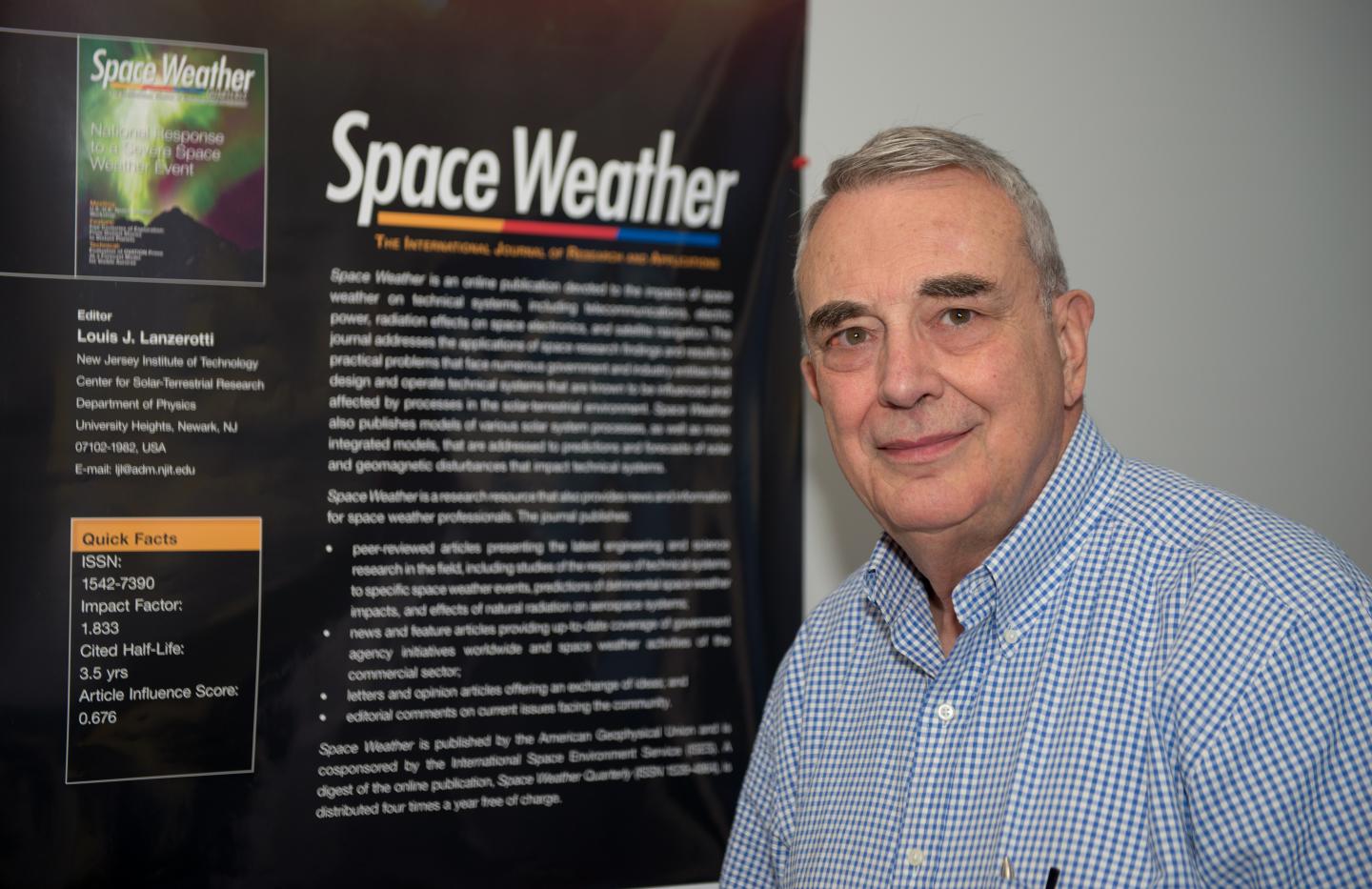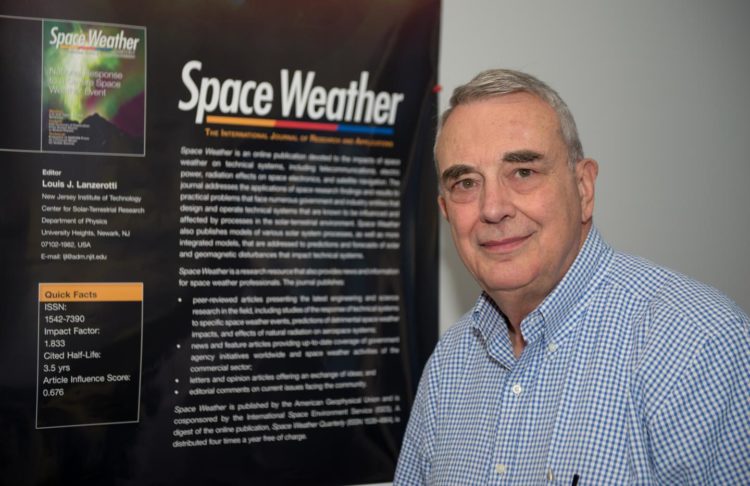
Credit: New Jersey Institute of Technology
Louis Lanzerotti, a distinguished research professor of physics best known for shedding light on the space environment around Earth and its impact on hardware in space and critical infrastructure on the ground, has been awarded the 2020 American Institute of Aeronautics and Astronautics (AIAA) James A. Van Allen Space Environments Award.
Named for the scientist credited with the discovery of the layers of charged protons and electrons held in place by Earth’s magnetic field – the Van Allen Radiation Belts – the award recognizes “outstanding contributions to space and planetary environment knowledge and interactions as applied to the advancement of aeronautics and astronautics.”
Lanzerotti, a member of NJIT’s Center for Solar-Terrestrial Research (CSTR), was tapped for his “significant contributions to our understanding of the space environment of the Van Allen radiation belts and leadership in establishing societal awareness of space weather.”
In the mid-1960s, just as U.S. space exploration was taking off, he began tackling some of the fundamental challenges of flying spacecraft in orbit around Earth. With a newly minted Ph.D. in physics from Harvard University, he joined AT&T Bell Labs to study Earth’s radiation belts just as the AT&T Telstar satellites were launched. He worked on radiation instruments for those first geosynchronous telecommunications satellites.
Lanzerotti said he relished the opportunity to do “engineering and science” in preparing satellites for travel in Earth’s near-space environment, a hazardous, then little-known realm subject to powerful geomagnetic fields and radiation.
More recently, he has served as the principal investigator of NJIT’s Radiation Belt Storm Probes Ion Composition Experiment (RBSPICE), instruments aboard NASA’s two Van Allen Probes that traveled for seven years through the magnetosphere collecting data. RBSPICE revealed, for example, hitherto undetected zones of high-energy helium ions within the radiation belts that surround our planet, the first observations of various fundamental plasma instabilities, new sources responsible for ion outflow and the most comprehensive view of the Earth’s ring current to date.
The instruments also detected an invisible force field thousands of miles from Earth that blocks high-energy “killer electrons” emitted by the Sun from damaging orbiting spacecraft and preventing dangerous radiation from reaching the planet’s surface. The shield, located just below the Van Allen radiation belts, prevents those highly energized particles from penetrating below altitudes of 7,200 miles from Earth. Though indications of the barrier had existed in the literature previously, he and colleagues were the first to show conclusively how strong and how spatially sharp it is.
“This instrument has provided a gold mine of valuable papers from which a better understanding of energetic particle injection from Earth’s windsock ‘tail’ region into the inner magnetosphere ensues, as evidenced in recent publications since launch in 2012,” Mary Hudson, Eleanor and Kelvin Smith Distinguished Professor of Physics at Dartmouth College, wrote in her letter of nomination.
The NJIT-led RBSPICE team received a Group Achievement Award from NASA citing the mission’s outstanding cost and schedule performance, as well as its groundbreaking science. NJIT team members, along with colleagues from the Applied Physics Laboratory at The Johns Hopkins University and Fundamental Technologies, LLC, also received individual certificates for their roles in conceiving, designing and building the RBSPICE.
The Van Allen Probe mission, managed by Goddard Space Flight Center as part of NASA’s Living With A Star program, is tasked with investigating changes in solar-driven space weather that can disable satellites, cause communication and power-grid failures, and disrupt GPS services on Earth.
In late 2015, Lanzerotti was the sole academic researcher invited to take part in the panel discussion, “Space Weather: Understanding Potential Impacts and Building Resilience,” convened in Washington, D.C. under the auspices of the Executive Office of the President of the United States and attended by scientists and engineers from academia and industry, as well as policymakers and elected officials.
But he did more than testify. Over the years, he has argued persuasively on behalf of space research before powerful policymakers, as in the mid-1970s, when he was asked to join the NASA Physical Sciences Committee, then an external advisory committee to the agency. At the time, he noted, there were “resource pressures” on NASA science and the opening of space research to a wider range of disciplines. Many committee members contended that studies of “particles and fields” in space around Earth should be finished and that research dollars would best be spent on other scientific topics.
Citing Lanzerotti’s extensive research on Earth’s upper atmosphere, from the ionosphere to the outer limits of the solar system, and his service to the scientific world, often as the chair of major advisory committees and boards of NASA, the National Academies and the National Science Foundation, as well as to his local communities, another giant in the field urged his selection for the medal.
“I believe Dr. Lanzerotti is uniquely qualified to receive the AIAA Van Allen Medal. He completely exemplifies the AIAA spirit and the Van Allen Medal focus of research in the space environment,” Daniel Baker, director of the Laboratory for Atmospheric and Space Physics and distinguished professor of planetary and space physics at the University of Colorado, Boulder, wrote to the awards committee.
Lanzerotti was the founding editor of the American Geophysical Union’s Space Weather journal and the chair or member of a number of national committees, including the National Science Foundations’s Geospace Portfolio Review. He served a six-year term on the National Science Board, from 2004 to 2010, and chaired its Committee on Science and Engineering Indicators much of that time.
Among his many awards in recent years are the American Geophysical Union William Bowie Medal and the U.S. Antarctic Service Medal. Mount Lanzerotti in Antarctica was named in his honor. He received the 2017 Arthur M. Bueche Award from the National Academy of Engineering for his “extraordinary impact on the engineering profession.”
Andrew Gerrard, CSTR’s director, added, “Lou gives back to NJIT in more ways than just his own research, through student mentoring and the endowment of the Lanzerotti Award, an outstanding undergraduate student award within the Physics Department at NJIT, to name two examples.”
###
About New Jersey Institute of Technology:
One of only 32 polytechnic universities in the United States, New Jersey Institute of Technology (NJIT) prepares students to become leaders in the technology-dependent economy of the 21st century. NJIT’s multidisciplinary curriculum and computing-intensive approach to education provide technological proficiency, business acumen and leadership skills. NJIT is rated an “R1” research university by the Carnegie Classification®, which indicates the highest level of research activity. NJIT conducts approximately $170 million in research activity each year and has a $2.8 billion annual economic impact on the State of New Jersey. NJIT is ranked #1 nationally by Forbes for the upward economic mobility of its lowest-income students and is ranked 53rd out of more than 4,000 colleges and universities for the mid-career earnings of graduates, according to PayScale.com. NJIT also is ranked by U.S.News & World Report as one of the top 100 national universities.
Media Contact
Tanya Klein
[email protected]
Original Source
https:/





